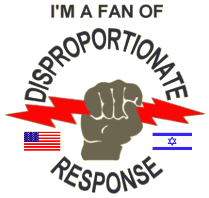Teachers as Tools of Jihad
There was a glowing article in the Detroit Free Press about two local teachers being selected to explore Saudi culture.While families throughout metro Detroit gathered for the Thanksgiving holiday this week, two teachers from the region are far from home on an all-expenses-paid cultural trip to Saudi Arabia.But,
Only 24 teachers around the country were selected for the training program, which is offered annually by Aramco, Saudi Arabia's government-affiliated oil company. The teachers' goal is to report what they find to their students.
The visit is all carefully choreographed. Teachers had to sign contracts agreeing that they would not leave the group to explore on their own, or they would be sent home and have to repay Aramco.I don't mean to dampen anyone's excitement, but how much are these 24 teachers going to learn about the reality of Saudi culture? If they're paying attention and not caught up in the thrill of visiting a dictatorial Islamic theocracy, they should have gotten their first lesson: Saudi society is tightly controlled. They will see only what their Saudi guides want them to see.
I bet they will be treated like royalty, even the women. I wonder if any of them are Jewish, or if any of the Christians will be allowed to wear any Christian-themed jewelry. Will they have to leave their crosses at home? Or maybe the Saudis only chose teachers who are smart enough to rise above those silly Judeo-Christian superstitions, so that issue will be avoided.
Back in the 1930s, Joseph Stalin used to dupe sympathetic reporters and other useful idiots using the same tricks so that the reporters ended up discarding the truth and passing off official Soviet lies about famine in the Ukraine.
The Soviets bolstered their famine denial by duping members of the foreign press and international celebrities through carefully staged photo opportunities in the Soviet Union and the Ukraine. The writer George Bernard Shaw, along with a group of British socialites, visited the Soviet Union and came away with a favorable impression which he disseminated to the world. Former French Premier Edouard Herriot was given a five-day stage-managed tour of the Ukraine, viewing spruced-up streets in Kiev and inspecting a 'model' collective farm. He also came away with a favorable impression and even declared there was indeed no famine.The Soviets took it a step further,
Back in Moscow, six British engineers working in the Soviet Union were arrested and charged with sabotage, espionage and bribery, and threatened with the death penalty. The sensational show trial that followed was actually a cynical ruse to deflect the attention of foreign journalists from the famine. Journalists were warned they would be shut out of the trial completely if they wrote news stories about the famine. Most of the foreign press corp yielded to the Soviet demand and either didn't cover the famine or wrote stories sympathetic to the official Soviet propaganda line that it didn't exist. Among those was Pulitzer Prize winning reporter Walter Duranty of the New York Times who sent one dispatch stating "...all talk of famine now is ridiculous."And while millions of Ukrainians starved to death, Stalin was rewarded.
Outside the Soviet Union, governments of the West adopted a passive attitude toward the famine, although most of them had become aware of the true suffering in the Ukraine through confidential diplomatic channels. In November 1933, the United States, under its new president, Franklin D. Roosevelt, even chose to formally recognized Stalin's Communist government and also negotiated a sweeping new trade agreement. The following year, the pattern of denial in the West culminated with the admission of the Soviet Union into the League of Nations.The Nazis were also able to fool the Red Cross by controlling what Red Cross inspectors were taken to see.
Stalin's Five Year Plan for the modernization of the Soviet Union depended largely on the purchase of massive amounts of manufactured goods and technology from Western nations. Those nations were unwilling to disrupt lucrative trade agreements with the Soviet Union in order to pursue the matter of the famine.
Even before the December 18, 1942 complaint by 12 allied governments, the Nazis had already turned the Theresienstadt ghetto into a propaganda tool to fool the rest of the world about their plans to exterminate all the Jews in Europe.And,
On Sept. 13, 1942, the Nazis had opened shops in Theresienstadt where the Jews could buy second-hand clothing and other goods. Eventually 8 such shops were opened.
On Dec. 8, 1942, the Nazis had opened a cafe, facing the main square in Theresienstadt, where the Jewish inmates could meet to socialize and listen to music.
On May 12, 1943, a bank was opened in Theresienstadt and camp money was printed to pay the Jews for their labor in the ghetto factories. This money could be used at the ghetto cafe or to buy items at the ghetto shops. In order to give the impression to the outside world that Theresienstadt was a regular town and not a concentration camp, the Nazis decided in July 1943 to change the numbers and letters on the streets and buildings to names, so that any friends or relatives sending mail to the camp post office would not suspect anything. The camp name "Ghetto Theresienstadt" was changed to "Jewish Settlement Theresienstadt."However,
In the Spring of 1944, the Nazis began extensive improvements to the ghetto in preparation for the Red Cross visit. In their mission to impress the IRC delegates, they outdid themselves, and after the beautification project was completed, they were so proud of their handiwork that they made a movie of Theresienstadt entitled "Der Führer schenkt den Juden eine Stadt" or "The Leader gives the Jews a town as a gift."
Before the Red Cross visit, the town square in Theresienstadt had been fenced off and a large circus tent was erected there in May 1943. Inside the tent, over 1,000 ghetto Jews did factory work in the Kistenproduktion, which was the making of boxes. After the Red Cross requested an inspection, factory production was stopped by the end of 1943, and in the Spring of 1944 the fence and the tent were removed and grass and flowers were planted in the square. A music pavilion was built on the south side of the square, just across from the camp cafe. The cafe and the camp shops were improved for the inspection.
A playground was built for the children in the Stadt park, across from the present Ghetto Museum building. The most beautiful park in the town, Brunnen Park, was made public and the Jews were now allowed to use all four of the parks in the ghetto.
On the outskirts of the town, the Sokol building, formerly used to house Jews who were suffering from encephalitis, was changed into a social club for cultural events with a library for the use of the Jews and a Synagogue. A Columbarium to hold the ashes of the Jews who died in the camp was built near the crematorium and tombstones were placed on the graves in the cemetery. The beautiful 18th century barracks buildings were refurbished and improved inside and out.
With Theresienstadt now beautified, the next step was to relieve the overcrowding in the ghetto so that the IRC would not realize the actual inhuman living conditions there. In September 1943, December 1943 and May 1944, just before the scheduled visit, there was a total of seven transports on which 17,517 Jews were sent to the death camp at Auschwitz.
The Czech Jews from these transports were placed in a "family camp" at the Auschwitz II camp known as Birkenau. The men, women and children were allowed to stay together in contrast to the other prisoners at Auschwitz-Birkenau who had to live in separate fenced-off sections where the men and women were segregated from each other. The Czech Jews were allowed to wear civilian clothes instead of the blue and gray striped prison uniforms that the other inmates had to wear. Most importantly, they were allowed to send letters back to Theresienstadt to tell the others about how well they were being treated in the camp. Six months after it was opened, the "family camp" was closed and only 1,168 of the Theresienstadt prisoners survived. The rest are presumed to have perished in the gas chamber.
The Red Cross inspection of the camp lasted for six hours but the cultural events went on for a week. During the week of the inspection, there were numerous performances of the children's opera called Brundibar in the new cultural hall in the Sokol building.
A jazz band, called the Ghetto Swingers, played in the music pavilion in the square. This was a real concession by the Nazis since they had banned jazz or swing music in Germany. Hitler regarded swing as "degenerate" music because two of the leading musicians, Benny Goodman and Artie Shaw, were Jewish.
The Nazi concentration camps typically had an orchestra which played classical music as the prisoners marched to work or to the gas chambers. The Germans loved classical music and Germany was world famous for the cultural contributions of Beethoven, Bach and Brahms. One could say that the Nazis literally put down their violins in order to kill the Jews.
Unfortunately, most of the Theresienstadt Jews did not live to enjoy their new improved ghetto. In the fall of 1944, after the June Red Cross visit, the transports to Auschwitz began again. In Sept. 1944, there were approximately 30,000 prisoners living in Theresienstadt. Eleven transports, totaling 18,402 inmates of the ghetto, were sent to Auschwitz between September 28, 1944 and October 28, 1944, the date of the last transport to be sent to the gas chambers of Auschwitz. Of the Jews sent to Auschwitz on these eleven transports, there were only 1,574 survivors. The rest died in the gas chamber, were worked to death or perished in the typhus epidemics which were rampant there. After these transports left, the number of Jews remaining in Theresienstadt was around 11,000, including 819 children under the age of 15.I'm sure all of the teachers will have glowing reports on Saudi society. Some may even report on its superiority to our own greedy, oppressive, imperialist, racist, sexist, homophobic, capitalist etc., society. I wonder though, if these teachers, in the interest of education and learning the truth, will ask about the gender and religious apartheid policies of the Saudi sharia-inspired legal system. Or are the questions as tightly controlled as their travel itinerary?
Labels: education, Saudi Arabia

 CHALLAH AKBAR
CHALLAH AKBAR











4 Comments:
I have seen this in Venezuela as well. The famous
visitors are shown a Bolivarian village where everything is provided and clean. Unlike the rest of Venezuela where there are shortages and poverty.
Then these people go back exclaiming the greatness of all they saw.
I suppose the reason that it's become such a popular trick with tyrants everywhere is because it works so well on a variety of useful idiots.
Hello!?!?!? Anybody there?!?!?!
Sometimes I wonder that myself. I'm just insanely busy. Christmas break is coming up and I should have time to breathe for a few days. Blogging may become more frequent . . . temporarily.
Post a Comment
<< Home